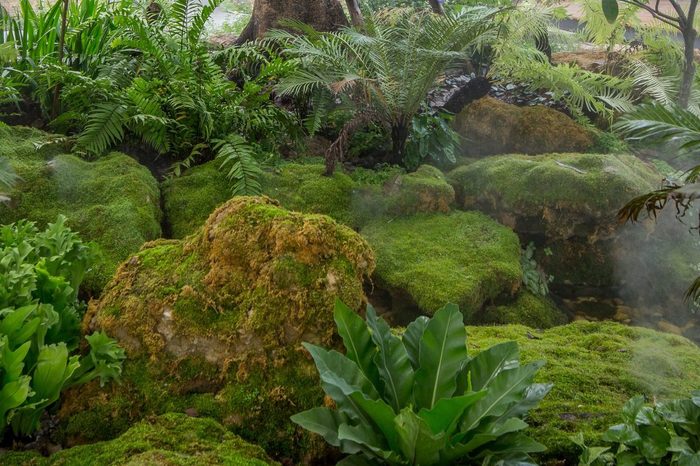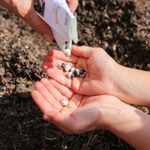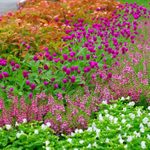What To Know About Moss Gardens

Mosses are the oldest living land plants and you can grow them in your newest outdoor garden. Learn how to create a soft, green oasis in your yard.
Our editors and experts handpick every product we feature. We may earn a commission from your purchases.
It’s not surprising that North Carolina-based moss expert Annie Martin titled her book The Magical World of Moss Gardening. She loves the year-round green visual appeal, the huge variety of shapes and sizes and the way some mosses display jewel-tone accents of crimson, gold and bronze.
Plus, mosses are so versatile that some species will grow on inhospitable soil, or even sun-baked stretches of asphalt and concrete. According to Martin, “There’s a right moss for every right place.”
On This Page
What Is a Moss Garden?
A moss garden is any deliberately cultivated outdoor spot that features moss. A moss garden is not necessarily all moss, although it certainly can be. “You can be a purist, but I’m not,” says Martin. “I want my grandmother’s daffodils in there, too.”
You can also grow an indoor moss garden.
Why Grow a Moss Garden?
A moss garden is more than just beautiful. It tastes bad to deer, requires no mowing or fertilizer and thrives where many other plants cannot. Got gravelly or clay-rich soil? No problem. A moss garden will grow in both. But the environmental benefits truly make moss gardens desirable and important.
A pioneer plant, moss helps break rock into soil. It captures and recycles nutrients and controls erosion while providing habitat to salamanders and many types of insects. Plus, although sphagnum moss (peatlands) covers just three percent of the earth’s surface, these soggy areas store twice as much carbon as all the world’s forests combined!
You can grow moss as a grass lawn alternative.
Where Do Moss Gardens Grow?
Species of moss grow all over the world in all types of surprising places, including Antarctica. Generally, mosses are immune to cold and grow in all U.S. Department of Agriculture Plant Hardiness Zones. Whether you’re an urban or rural dweller with bright hot sun or a frozen landscape, there’s a moss species for your climate.
In her book, Martin highlights 25 species for the beginning moss gardener. Some prefer alkaline soil, some prefer acidic soil, some grow in mounds and some grow in sideways. Martin suggests doing some research about mosses for your area before starting a moss garden.
How To Grow a Moss Garden
It’s not as difficult as you might think!
How to find or buy your moss
- First, closely check your property. You might be surprised to discover moss already in your landscape.
- Then look in nontraditional places. Martin says she always has her moss radar running, and particularly delights in rescuing live moss from places where it’s certain to be destroyed. She has rescued moss from behind dumpsters, from sidewalk cracks, development zones and abandoned sites. She cautions to always get permission before harvesting moss from a private property. She also emphatically implores people to never steal moss from public lands or preserved areas.
- If you’re buying moss, Martin encourages purchases from a dedicated mossery, where the species are sure to be correctly identified. Don’t mistakenly buy dyed or dried/preserved moss sold in craft stores, she says.
How to plant a moss garden
Some avid moss gardeners convert huge areas to solid moss, but Martin advises beginners to think small. “Find a beautiful tree and give it a moss skirt or apron, or create a smallish moss focal point,” she says.
- If you find moss lurking under a patch of grass, remove the entire section, discard the grass and start a new colony with new moss fragments in similar sun/shade conditions.
- Remove all plant life from your chosen spot, then hard-pack the ground.
- Lightly score the ground with a stick, rock or pronged tool.
- Add the moss fragments and use a tamper to help moss rhizomes attach to the ground. If you don’t have a tamper, Martin advises walking on the fragments.
- Water your new colony three times per day for at least three minutes each session.
How to maintain a moss garden
- Water: What many people may think of as the “leaves” of a moss plant are likely the entire plant. A single moss plant is sometimes just one cell thick! That’s why frequent-but-short watering sessions are necessary for building up a robust moss colony. At her mossery, Martin waters each section three times per day for at least three minutes. She recommends a sprinkler system with a timer to make the watering task less onerous.
- Rake: That’s how you create more moss fragments and expand your colony. Use an actual rake or “finger-rake” with your hand. Pick up all the loosened fragments and you have the beginnings of a new moss colony. Start again by clearing a patch of ground, lightly scoring the surface and tamping the moss fragments into the ground, followed by short-but-frequent sessions of watering.
- Weed: Moss gets its nutrients from the sun and air, not the soil. That’s why you remove weeds, conifer needles, bark, deciduous leaves and other plant debris that lands on or grows up through the garden. Weeding moss can be a zen experience, says Martin. “Mosses are the oldest living land plants and weeding allows you to get up close and personal with these ancient plants,” she says. “To me, these tiny plants make my heart smile and my spirit soar.”



